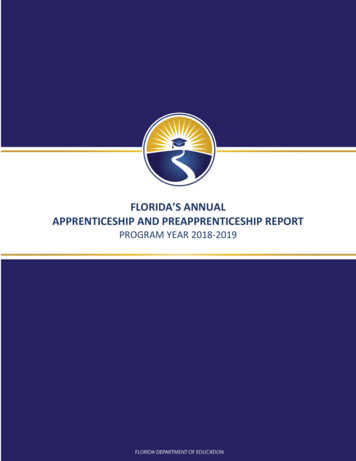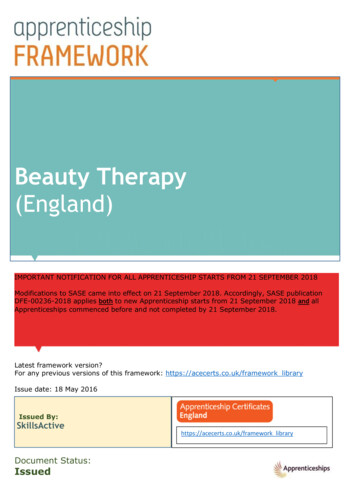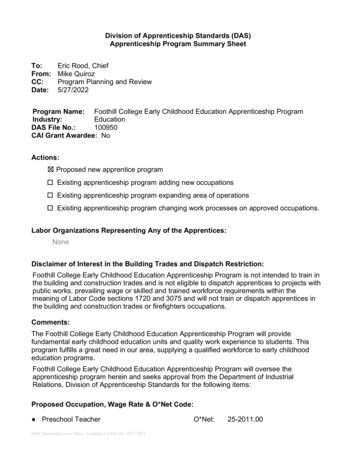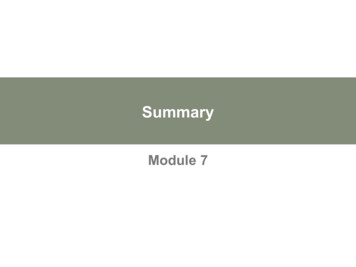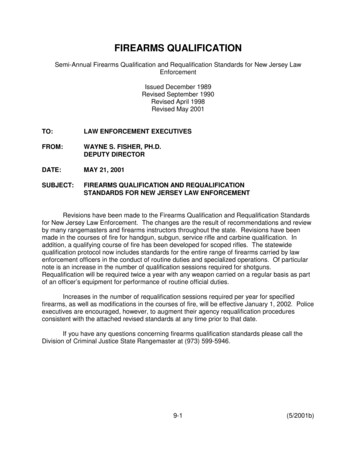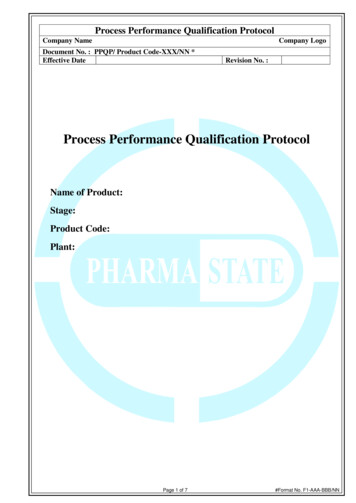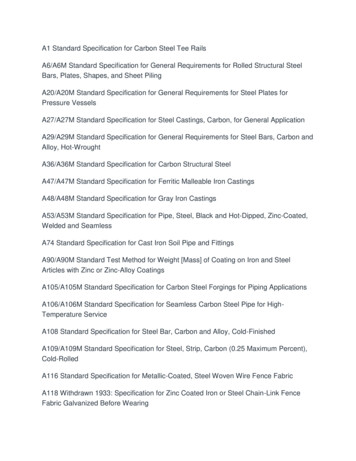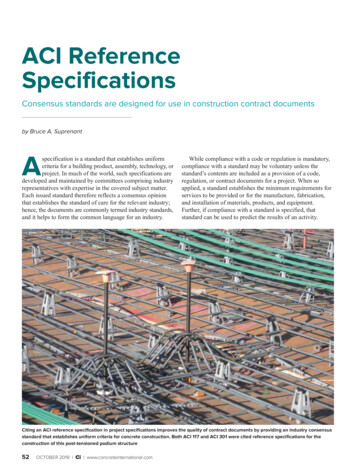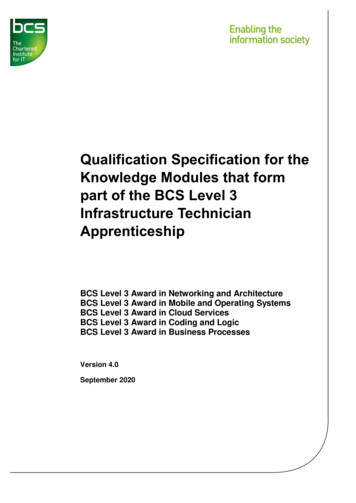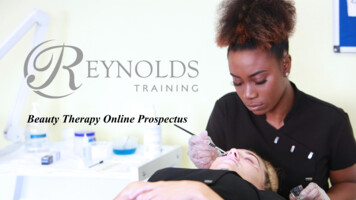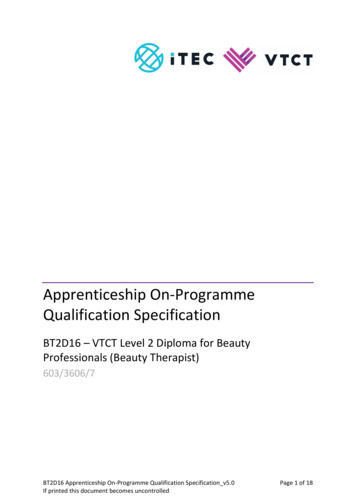
Transcription
Apprenticeship On-ProgrammeQualification SpecificationBT2D16 – VTCT Level 2 Diploma for BeautyProfessionals (Beauty Therapist)603/3606/7BT2D16 Apprenticeship On-Programme Qualification Specification v5.0If printed this document becomes uncontrolledPage 1 of 18
About VTCTVTCT is a market-leading Awarding & Assessment Organisation offering vocational and technicalqualifications in a range of ‘services to people’ sectors.Combined, VTCT & iTEC have over 2,000 approved centres in over 40 countries across the world.Offering smarter support for brighter futures, with award-winning resources including:ManageAssess, Pivot Point, Smart End Point Assessment (SEPA) and Cengage.The qualifications suite offered by VTCT & iTEC spans a range of sectors including hairdressing andbarbering, beauty therapy, complementary therapy, sport, active health and fitness, business, retail,and learning and development.For more information visit us at www.itecworld.co.uk and www.vtct.org.uk, or contact our dedicatedCustomer Support Team via email; customersupport@vtct.org.uk or call 44 (0)23 8068 4500All qualifications are awarded by VTCT. All material in this publication is copyright of VTCT Vocational Training Charitable Trust, 2018, 2019, 2020.BT2D16 Apprenticeship On-Programme Qualification Specification v5.0If printed this document becomes uncontrolledPage 2 of 18
ContentsAbout VTCT . 2Contents . 31. Qualification at a glance. 42. About this qualification . 52.1 Purpose . 52.2 Content . 52.3 Progression . 52.4 Support. 63. Qualification structure . 73.1 Transferable skills. 83.2 Transferable skills matrix . 104. Guidance on assessment . 114.1 Centre assessor requirements . 114.2 Internal quality assurance . 124.3 External quality assurance . 135. Assessment . 145.1 Summary of assessment methods . 145.2 External assessment. 145.2.1 Theory examinations. 145.2.2 Retaking external examinations. 155.2.3 Reasonable adjustments and special considerations . 155.3 Internal assessment . 155.3.1 Practical observations . 155.3.2 Realistic working environment (RWE) . 155.3.3 Simulation . 165.3.4 Witness statements . 165.3.5 Portfolio of evidence . 165.3.6 Authentication of apprentice work . 17BT2D16 Apprenticeship On-Programme Qualification Specification v5.0If printed this document becomes uncontrolledPage 3 of 18
1. Qualification at a glanceQualification titleVTCT Level 2 Diploma for Beauty Professionals (BeautyTherapist)Qualification number603/3606/7Product codeBT2D16First registration date1st October 2018Age range16-18, 19 Total Qualification Time (TQT)600Guided Learning (GL) hours391AssessmentTo be awarded this qualification, apprentices mustsuccessfully achieve the following assessments: External theory examinations Practical observations Portfolio of evidenceGradingPass/FailEntry requirementsLearners who wish to undertake this qualification must alsoachieve the VTCT (ITEC) Level 2 Award in Infection Prevention(COVID-19) for Beauty Therapy and Nail Services qualificationor a regulated equivalentSupport materialsApprenticeship On-Programme Qualification (On-programmeassessment book)BT2D16 Apprenticeship On-Programme Qualification Specification v5.0If printed this document becomes uncontrolledPage 4 of 18
2. About this qualification2.1 PurposeThis qualification is for apprentices undertaking the Beauty Therapist Professional ApprenticeshipStandard. On completion of this qualification apprentices will be able to perform beauty therapytreatments and implement safe working practices which meet legal, industry and organisationalrequirements. The apprentices will be able to carry out, maintain and store detailed and confidentialclient consultations, enabling the choice of the most appropriate treatments and products and willbe able to select, use and apply a range of beauty therapy techniques, tools and equipment toprovide tools and equipment to provide: waxing serviceshand and nail treatmentsfoot treatmentsfacial skin care treatmentseyelash and eyebrow treatmentsmake-up applicationbasic massage treatments (back, neck and shoulder)Apprentices will maintain the standards of professional appearance and the salon/spa image,etiquette and required hygiene. Apprentices will be able to provide advice and recommendations onbeauty treatments, appointments and service timings. Apprentices will also be able to facilitate theclient journey, from appointments through completion of the services to handling payments whilstportraying the professionalism and values expected by the beauty therapy industry.2.2 ContentApprentices must achieve all mandatory units which include: Provide waxing servicesProvide hand and nail treatmentsProvide foot treatmentsProvide facial treatmentsProvide eyelash and eyebrow treatmentsProvide make-up applicationProvide basic massage treatmentsApprentices will also develop the following transferable skills which are embedded across the units: Professionalism and valuesSafe working practicesCore behavioursPlease refer to the on-programme assessment book for individual unit criteria and transferable skills.2.3 ProgressionOn completion of this qualification apprentices will be able to perform beauty therapy treatmentsand implement safe working practices which meet legal, industry and organisational requirements.Apprentices will progress towards taking the Beauty Therapist Professional Apprenticeship StandardEnd-point Assessment. On completion of this qualification apprentices can lead to additionalqualifications at Level 3.BT2D16 Apprenticeship On-Programme Qualification Specification v5.0If printed this document becomes uncontrolledPage 5 of 18
2.4 SupportThis qualification has been developed through the beauty sector “Trailblazers” apprenticeshipstandards. VTCT in collaboration with other awarding organisations, employers and the Institute forApprenticeships have developed a beauty apprenticeship standard which ensures that apprenticeswho complete the qualification meet business needs in terms of Knowledge, Skills and Behaviours(KSBs). Full details on awarding organisations and employers who have contributed to thisqualification can be found on the Institute for Apprenticeships 2D16 Apprenticeship On-Programme Qualification Specification v5.0If printed this document becomes uncontrolledPage 6 of 18
3. Qualification structureTo be awarded the VTCT Level 2 Diploma for Beauty Professionals (Beauty Therapist) apprenticesmust achieve all mandatory units.The minimum TQT required to achieve this qualification is 600.ProductcodeUnit titleLevelGLUnitreferencenumberMandatory unitsUBT259Provide waxing services261T/617/2197UBT260Provide hand and nail treatments253A/617/2198UBT261Provide foot treatments253F/617/2199UBT262Provide facial treatments268K/617/2200UBT263Provide eyelash and eyebrow treatments245M/617/2201UBT264Provide make-up application241T/617/2202UBT265Provide basic massage treatments270A/617/2203Transferable skills – embedded within all of the above unitsProfessionalism and valuesSafe working practicesCore behavioursBT2D16 Apprenticeship On-Programme Qualification Specification v5.0If printed this document becomes uncontrolledPage 7 of 18
3.1 Transferable skillsProfessionalism and valuesSkills embedded within the units:Carrying out and maintaining beauty therapy legal, industry and organisational requirements forprofessionalism and demonstrating a passion for the industryMeeting organisational and industry standards of appearanceWorking under pressure, observing time management and self-managementProviding advice and recommendations on the beauty services/treatments, products, aftercareand appointmentsCompleting services/treatments in a commercially viable time and to a high standardDemonstrating an appreciation of equality and diversityDescribing the range of services/treatments and products in the beauty therapy industryMaintaining client confidentiality and rights to support the client journeyDemonstrating excellent verbal and non-verbal communication skillsDealing with problems within the scope and responsibilities of the occupation, swiftly seekingassistance from a senior member of staff when requiredKnowledge embedded within the units:Beauty therapy industry, legal and organisational requirementsProcedures, guidelines, codes of practice, ethics, equality and diversity and quality assurancesystemsTime and self-management principlesBeauty therapy duties, standards of appearance, personal hygiene, etiquette, housekeepingCommercially viable times for the completion of services/treatmentsContinuing professional developmentConsumer Rights Act, the Data Protection Act and GDPRThe role of the reception and associated areasHow to complete a sale and handle payments from clientsHow to make appointments for salon services, the types of products and treatments in beautytherapy and related industries, client confidentiality and rights, the client journey (from meet andgreet to advice and support)The importance of aftercare advice and recommendationsVerbal and non-verbal communication skillsHow to deal with problems within the scope and responsibilities of the occupation, swiftly seekingassistance from a senior member of staffBT2D16 Apprenticeship On-Programme Qualification Specification v5.0If printed this document becomes uncontrolledPage 8 of 18
Safe working practicesSkills embedded within the units:Meeting legal, industry and organisational requirements: maintaining effective, hygienic and safeworking methodsMeeting health and safety considerationsAdhering to workplace, suppliers’ or manufacturers’ instructions for the safe use of equipment,materials and productsMaintaining the client’s modesty, privacy and comfortMinimising risks of cross-infection, injury or fatiguePromoting environmental and sustainable working practicesEnsuring personal hygiene and protection meets industry, organisational and local authorityrequirementsUsing, storing and disposing of personal protective equipment correctlyKnowledge embedded within the units:Legal, industry and organisational requirementsUse of tools, equipment, materials and productsWorkplace housekeeping: cleaning, disinfection, sterilisation, waste disposalSupplier or manufacturers’ instructionsProtection of self and clientDirect and indirect cross-infectionContra-indications and contra-actionsMethods that promote environmental and sustainable working practicesHow to recognise and reduce the risk of injury to self and others by maintaining correct postureHealth and safety legislation and practiceCore behavioursThese behaviours ensure that clients receive a positive impression of both the organisation andthe individual and meet industry standards of behaviour for a beauty professional:Personal and professional ethics: demonstrate a commitment to quality, maintain honesty,integrity and confidentialityFlexible and positive attitude: adapt positively to changing work priorities and patterns whennew tasks need to be completed or requirements changeMaintain client care principles and practices: show clients respect at all times and in allcircumstances, demonstrate client empathy, sensitivity and awarenessBT2D16 Apprenticeship On-Programme Qualification Specification v5.0If printed this document becomes uncontrolledPage 9 of 18
3.2 Transferable skills 65Transferable skillsLearning outcomeProfessionalism and valuesLO1, LO2, LO3, LO4Safe working practicesLO1, LO2, LO3, LO4Core behavioursLO1, LO2, LO3, LO4Professionalism and valuesLO1, LO2, LO3, LO4, LO5, LO6Safe working practicesLO1, LO2, LO3, LO4, LO5, LO6Core behavioursLO1, LO2, LO3, LO4, LO5Professionalism and valuesLO1, LO2, LO3, LO4Safe working practicesLO1, LO2, LO3, LO4Core behavioursLO1, LO2, LO3, LO4Professionalism and valuesLO1, LO2, LO3, LO4Safe working practicesLO1, LO2, LO3, LO4Core behavioursLO1, LO2, LO3, LO4Professionalism and valuesLO1, LO2, LO3, LO4, LO5, LO6, LO7, LO8, LO9, LO10,LO11, LO12, LO13Safe working practicesLO1, LO2, LO3, LO4, LO5, LO6, LO7, LO8, LO9, LO10,LO11, LO12, LO13Core behavioursLO1, LO2, LO3, LO4, LO5, LO6, LO7, LO8, LO9, LO10,LO11, LO12, LO13Professionalism and valuesLO1, LO2, LO3, LO4Safe working practicesLO1, LO2, LO3, LO4Core behavioursLO1, LO2, LO3, LO4Professionalism and valuesLO1, LO2, LO3, LO4Safe working practicesLO1, LO2, LO3, LO4Core behavioursLO1, LO2, LO3, LO4BT2D16 Apprenticeship On-Programme Qualification Specification v5.0If printed this document becomes uncontrolledPage 10 of 18
4. Guidance on assessment4.1 Centre assessor requirementsThis qualification is assessed and quality assured by centre staff. They will set work to improvepractical skills, knowledge and understanding. For practical elements, apprentices will be observedby centre assessors. All work must be collected in a portfolio of evidence and cross-referenced torequirements listed in the on-programme assessment book.The on-programme assessment book is the apprentice’s property and must be in their possessionwhen they are being assessed or quality assured. It must be kept safe, in some cases the centre willbe required to keep it in a secure place. The apprentice will complete the book in conjunction withthe assessor(s) to show achievement of all learning outcomes, assessment criteria and ranges.AssessorqualificationsThe centre assessor must hold, or be working towards a valid assessorqualification or equivalent such as: OccupationallycompetentD32 Assess candidate performance*D33 Assess candidate using differing sources of evidence*A1 Assess candidate performance using a range of methods*A2 Assess candidate performance through observation*Level 3 Award in Assessing Competence in the Work EnvironmentLevel 3 Award in Assessing Vocationally Related AchievementLevel 3 Certificate in Assessing Vocational AchievementLearning and Development Unit 9D – Assess workplace competenceusing direct methodsLearning and Development Unit 9DI – Assess workplace competenceusing direct and indirect methods* Holders of A1, A2, D32 or D33 qualifications must work to the reviewedNational Occupational Standards for Learning and Development.The centre assessor must hold a regulated qualification in Beauty Therapy atLevel 3 or equivalent.The assessor must have sufficient operational experience within the beautytherapy industry that can be evidenced, is current and relevant to thequalification. Experience could be gained through time in a role in the beautyindustry which could include, but is not limited to: Beauty TherapistSenior Beauty Therapist/SpecialistSalon managerTrainerLecturerVerifierThe sufficiency and equivalency of the assessor competence is at thediscretion of the EQA. Should the sufficiency and equivalency of the assessorcompetence not be met, VTCT recommends that if not already held; staffinvolved in the delivery of a qualification, must achieve that qualificationthemselves within 18 months.BT2D16 Apprenticeship On-Programme Qualification Specification v5.0If printed this document becomes uncontrolledPage 11 of 18
Familiar with thequalificationThe centre assessor must have an in-depth technical knowledge of thequalification, units and standards of competencies required. They must beable to interpret current working practices, technologies and products withinthe area of work and be committed to upholding the integrity of thequalification.CredibleThe centre assessor should have access to, and be engaging with, continuousprofessional development activities in order to keep up to date withdevelopments and any issues relevant to the qualification and/or its units.These may include those offered by the awarding organisation or otherrecognised and relevant providers in the sector.A minimum of 50 hours CPD is required per annum of which 30 hours shouldbe applied practical skills in a salon (1st September – 31st August) which mustbe demonstrated through a personal development plan (PDP) or as areflective diary. Responsibility for CPD lies with the individual, not the centrethey work for.For information on the roles, responsibilities, authorities and accountabilities of assessors refer toVTCT’s Centre Handbook and Approval Criteria, which can be downloaded from the VTCT website.4.2 Internal quality assuranceCentres must have an internal quality assurer (IQA) to ensure assessment decisions are consistentlyapplied between assessors, and that apprentice work is to the required standard. Each assessor’swork must be checked and confirmed by the IQA. Assessment decisions must be standardised toensure that all apprentices’ work has been assessed to the same standard and is fair, valid andreliable.Evidence of internal quality assurance must be recorded, retained and made available for theexternal quality assurer (EQA).Internal QualityAssurer (IQA)qualificationThe centre IQA must hold, or be working towards a valid IQA qualification orequivalent such as:OccupationallycompetentThe centre IQA must hold a regulated qualification in Beauty Therapy at Level3 or equivalent.D34 Internally verify the assessment process*V1 Conduct internal quality assurance of the assessment process*Level 4 Award in the Internal Quality Assurance of AssessmentProcesses and Practice Level 4 Certificate in Leading the Internal Quality Assurance ofAssessment Processes and Practice Learning and Development Unit 11 – Internal Quality Assurance* Holders of D34 or V1 qualifications must work to the reviewed NationalOccupational Standards for Learning and Development. The IQA must have sufficient operational experience within the beautytherapy industry that can be evidenced, is current and relevant to thequalifications. This must be of sufficient depth to be effective and reliablewhen verifying judgements about assessors’ assessment processes anddecisions. The sufficiency and equivalency of the IQA competence is at thediscretion of the EQA. Should the sufficiency and equivalency of the assessorBT2D16 Apprenticeship On-Programme Qualification Specification v5.0If printed this document becomes uncontrolledPage 12 of 18
competence not be met, VTCT recommends that if not already held; staffinvolved in the delivery of a qualification, must achieve that qualificationthemselves within 18 months.Familiar with thequalificationThe centre IQA must have an in-depth technical knowledge of thequalification, units and standards of competencies required. They must becommitted to upholding the integrity of the qualification.CredibleThe centre IQA should have access to, and be engaging with, continuousprofessional development activities in order to keep up to date withdevelopments and any issues relevant to the qualification and/or its units.These may include those offered by the awarding organisation or otherrecognised and relevant providers in the sector.A minimum of 50 hours CPD is required per annum of which 30 hours shouldbe applied practical skills in a salon (1st September – 31st August) which mustbe demonstrated through a personal development plan (PDP) or as areflective diary. Responsibility for CPD lies with the individual, not the centrethey work for.For information on the roles, responsibilities, authorities and accountabilities of IQAs, and internalquality assurance more generally, refer to VTCT’s Centre Handbook and Approval Criteria, which canbe downloaded from the VTCT website.4.3 External quality assuranceAn external quality assurer (EQA), appointed by VTCT, will visit the centre to sample and qualitycheck assessments, the internal quality assurance process and the evidence gathered. Between visitsEQAs are available to offer advice and guidance on any aspect of quality assurance, via telephone oremail; additional quality assurance visits can be arranged.Random sampling is arranged between the centre and the EQA. The EQA will choose a sample ofnamed apprentices to cover a variety of skills, knowledge, units and assessors. Through the samplingprocess the EQA will seek to assure that all assessment decisions made at the centre are consistent,fair, valid, and reliable. The EQA will also seek to confirm that all assessments conducted meetnational standards.BT2D16 Apprenticeship On-Programme Qualification Specification v5.0If printed this document becomes uncontrolledPage 13 of 18
5. Assessment5.1 Summary of assessment methodsThis qualification comprises internal and external assessments. Apprentices must achieve theassessments detailed in the table below.Unit product codeExternal theoryexaminationPracticalobservationsSupporting Evidence UBT259UBT260UBT261UBT262UBT263UBT264UBT2655.2 External assessment5.2.1 Theory examinationsTheory examinations will be set and marked by VTCT. The theory exams will consist of multiplechoice questions. Questions will vary year on year and will cover all learning outcomes within thoseunits that are externally examined. Each theory exam has a pass mark of 70%.Examinations must be undertaken by apprentices under controlled examination conditions inaccordance with VTCT’s policies and procedures for external assessment.Overview of theory examinations:Unit product code1 x Overarching anatomy and1 x External theory examinationphysiology external theoryfor knowledge andexamination BT2D16.EX1understanding(Maps to all anatomy and physiologycriteria across mandatory units)UBT259UBT260UBT261UBT262UBT263UBT264UBT265 BT2D16 Apprenticeship On-Programme Qualification Specification v5.0If printed this document becomes uncontrolled Page 14 of 18
5.2.2 Retaking external examinationsApprentices who fail to achieve the required Pass mark are permitted to re-sit after having sufficientteaching and additional study time. There is no limit to the number of retakes an apprentice cancarry out. External examinations will be subject to rotation by VTCT. Re-sits are subject to charges asstated in the VTCT Service Fees.5.2.3 Reasonable adjustments and special considerationsA reasonable adjustment is an adjustment made to an assessment for a qualification that isapproved or set in place before an assessment activity takes place; it constitutes an arrangement togive the apprentice access to the qualification.Information on the reasonable adjustments and special considerations allowed for the externalexaminations within this qualification can be found in the document library on the Linx2Exchangesection of the VTCT website.5.3 Internal assessment5.3.1 Practical observationsApprentices must carry out practical tasks which must be observed and marked by centre assessors.Assessors will observe the performance of practical tasks and must judge apprentices’ performanceagainst specified assessment criteria stated in the Apprenticeship On-programme Qualificationassessment book. The assessor will sign off an outcome when all the criteria have been completelyachieved.The practical assessment must take place in a real or realistic working environment on a real orrealistic client.Practical assessments should be administered towards the end of the period of learning whenapprentices are suitably prepared. Centres may determine the precise timing of practicalassessments to suit local needs. Where evidence is not naturally occurring during practicalobservations, supplementary evidence may be used where specified within the Apprenticeship Onprogramme Qualification assessment book.5.3.2 Realistic working environment (RWE)Apprentices should be assessed through performance in the workplace.As far as reasonably practicable the assessment should match conditions of a realistic workingenvironment (RWE). In other words, the conditions should match those found in the workplace,including facilities, equipment, products, as well as relationships, constraints and pressures.The RWE must adhere to the following principles: Providers must develop realistic management procedures that incorporate a ‘salon image’and sales and marketing policy to attract the type and number of clients needed to ensurethe requirements of the qualification can be met and achievedAll on-programme assessments must be carried out under realistic commercial pressuresand on clients, not other apprentices within the same cohort. Clients used should vary in ageand ethnicityAll services/treatments performed must be completed in a commercially acceptabletimescaleApprentices must be able to achieve a realistic volume of workThe space per working area must conform to current health and safety legislation andcommercial practiceBT2D16 Apprenticeship On-Programme Qualification Specification v5.0If printed this document becomes uncontrolledPage 15 of 18
The range of services/treatments, professional products, tools, materials and equipmentmust be current and available for useA reception facility where clients are greeted, payment is taken and general enquiries andappointments can be made. A payment facility must be availableA retail facility must be provided, stocked with products that relate to the clients’ needs andcomplements the services/treatments offeredAll by-laws, legislation or local authority requirements that have been set down in relation tothe type of work that is being carried out must be taken into full account5.3.3 SimulationSimulation is not acceptable for any units within this qualification.5.3.4 Witness statementsA witness statement can made by someone present while the apprentice was performing an activityon-the-job and may be used to support the assessment process.Witness testimony should only be used as an additional method of assessment when allobservations have been carried out by an assessor.Where witnesses are used: Evidence must be available that demonstrates the individual has the necessary expertise inthe area for which they are providing the testimonyAny relationship they have with an apprentice must be declared to the assessor todetermine the value of the testimony providedThey must be fully briefed and clear about the purpose of their testimony, it will only beregarded as supporting/supplementary evidence and the final decision regarding theapprentice’s ability to meet the evidence requirements will be the responsibility of the onprogramme assessorThose who could fulfil the role of a witness for this qualification could include (this list if notexhaustive): TherapistSalon ManagerReceptionistTrainerMarketing directorClient5.3.5 Portfolio of evidenceAs part of this qualification apprentices are required to produce a portfolio of evidence whichcontains assessed evidence covering all the assessment criteria and range (where appropriate) ineach unit, these can be found within the Apprenticeship On-programme Qualification assessmentbook. A portfolio of evidence will confirm the knowledg
This qualification is for apprentices undertaking the Beauty Therapist Professional Apprenticeship Standard. On completion of this qualification apprentices will be able to perform beauty therapy . UBT265 Provide basic massage treatments 2 70 A/617/2203 : Transferable skills - embedded within all of the above units: Professionalism and values
